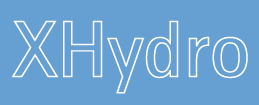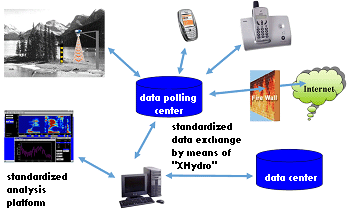
Motivation for the development of XHydro
Timely information about the water levels in the rivers from the major gauging stations is essential for inland navigation and the water-resources management activities of the German Federal government and Federal states - and in times of threatening inundations - also for the general public. For this reason it is necessary that these gauging stations are equipped with automatic measuring devices and data-transmission facilities. However, because these stations are run by different operators, and their technical equipment is not - and, in fact, cannot be - uniform, a common standard of data quality must be guaranteed for the comparability of the water-level data. This minimum quality standard was set in Germany with the "Manual for water level gauging and discharge measurements" by the joint working party on water issues of the Federal government and the Federal states "LAWA".To facilitate the cost-efficient exchange of data between organizations and institutions it is essential that the semantics and the syntax as well as some technical standards are defined.
The protocols applied so far in polling the measured data from the monitoring stations in the field used to be oriented mainly at the requirements of the hardware or the technical equipment of the monitoring stations and the facilities and the quality of data transmission available on site. This practice resulted in a diversity in data protocols and data formats, so that today the data-polling centres must be equipped with multi-protocol servers to be able to gather the data from the diverse monitoring stations.
For the smooth and thus economic operation of the gauging networks in the long run it is of great importance that also the communication lines or the interfaces of the networks of different operators become harmonised. That is why a working group of the German Federal Waterways and Shipping Andministration (WSV) under the guidance of the Federal Institute of Hydrology (BfG, Department M1) devised a concept for the harmonisation of the polling of digital data from gauging stations on Federal waterways on the basis of Web Services.
 |
A new standard for water-level data transmission
|
The BfG commissioned the companies Kisters and disy to develop the XML dialect "XHydro" for optimised transmission of gauging-station data in the WSV. Key design criteria were neutrality in terms of fields of application, user affiliation, and nationality as well as openness for extensions by additional user-specific data contents.
Some basics about Web Services
Web Services are not an absolutely new approach to machine-to-machine interaction over a network. What makes them interesting (in the XHydro context) is the fact that they use the accepted standards XML and HTTP, what ensures cross-platform usability and independence of manufacturers. Web services are now making the success of the WWW available for the automated data exchange within distributed systems.
Web Services use XML (Extensible Markup Language) as data format and preferentially SOAP (Simple Object Access Protocol) as protocol for the transmission of the data. SOAP can be described roughly as follows: If a user enters data e.g. into the search form of a Web search engine, these data are transmitted by means of the HTTP protocol to the corresponding server. SOAP messages use the same mechanism (i.e. HTTP). It is merely necessary to observe certain SOAP-specific conventions, so that Web Services may be used with any device able to be connected to the Internet, for example, also with modern mobile phones.
 |
All data paths shown by the arrows are based on Web Services. So it is possible
to transmit data from the source also via several inter-mediate stations without
protocol conversion.
|
Scheme of data exchange based on Web Services

